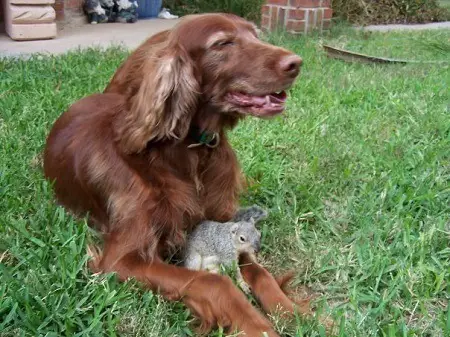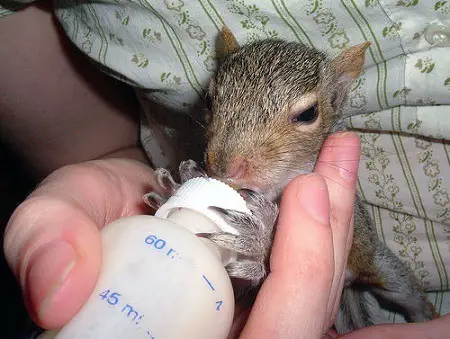As an Amazon Associate I earn from qualifying purchases.
Can you have squirrels as pets? This is a popular question often asked of veterinarians. The short answer is no; you should not try to capture and keep an adult squirrel. They are born in the wild and are extremely difficult to train for a domestic lifestyle.
However, baby squirrels are sometimes rescued in the wilderness after being abandoned by their moms or getting injured. These may be cared for by a vet or wildlife rehabilitator who can nurse the baby to healthy adulthood and then safely release it into the woods.
Also, squirrel breeders sell babies as pets for those who are willing to take on the challenge. Before making this decision, it is a good idea to find out what will be needed to raise healthy, well-adapted baby squirrels as pets. They are not as docile as dogs nor as independent as cats, and extra care will be required.
Set Up A Cage
Keeping squirrels as pets means you will have to make or build a sizable cage as housing. The cage can be kept indoors or outdoors in temperate weather. Squirrels like clean living space and they toss debris like leftover food or toys out of the cage. They’ll even defecate and urinate on the sides of the cage to keep it away from the interior. You might want to place newspaper or a tarp under the cage to catch fallout.
Outdoor cages should be sheltered from the elements and protected in bad weather, like heavy rain or snow and high winds. If the cage is placed in a drafty location, as in a shed or barn, it’s probably best to partially cover the cage with a heavy cloth to hold in the heat when the temperature drops.
Babies need body heat to survive. A warming blanket or heating pad set at about 100 degrees can be placed under a soft blanket that serves as bedding. The heating cushion should be under just part of the bedding so that the other part remains cool if the baby tries to move away and cool down. A small animal pouch like those used for possums will help to keep the baby warm as well. If a baby squirrel does get chilled, don’t feed it until the body temperature rises to normal, as babies cannot digest food while cold.
Keep the cage clean as you would for other domestic pets like hamsters or gerbils.
Provide Play Time
Little ones need toys to play with, which will help to focus their attention, keep them actively moving for healthy development, and fosters a positive mindset, so they don’t become anxious or depressed. Small animal toys are available in pet stores and pet supply outlets.

Let the squirrel out of its cage a couple of hours each day. Scampering around the house or designated area is good for their bodily development and sense of adventure. Squirrels are quick, so have the area ready with secured entryways so the animals cannot speedily escape.
Be careful allowing pets to share common areas. You never know how a wild animal is going to react, even if it is born in captivity. Nor can you be sure how your usually friendly cat or dog will react to a new little intruder that is completely alien and probably unwanted by your other household pets. Keep young children away from the cage, as squirrels require careful handling by those who know how to do it safely.
Feed Squirrels Appropriately
Although it may seem natural to feed squirrels snack foods like those found in the parks or at campgrounds, these small mammals should be fed a nutritious and balanced diet. Like young children, they love foods that aren’t good for them, so you’ll need to plan their menus carefully. The local veterinarian can advise you on the best available pet food products for your squirrel. Alternately, natural foods like nuts and berries along with certain kinds of greens are beneficial. You’ll want to take the time to find out what to feed your squirrel, and how much.
Babies require small frequent feedings of special milk-type formula given through a syringe. At three weeks of age, they usually require six daily feedings, and by eight weeks they are starting to nibble solid food. If they don’t get the right food, they could develop diarrhea and even die.
Fresh water can be provided through a plastic tube and syringe attached to the cage. Some owners put a small dish of water in the bottom of the cage, although the squirrel will likely make a mess of it. Be sure to place something under the water dish to catch drips or spills.
Take Safety Precautions
Baby squirrels are so cute and cuddly looking that many people forget how dangerous they can be. Even small babies have long claws intended to dig into tree trunks for climbing and securing a seat on a branch. Claws also tear apart food for easier eating. Their sharp teeth can likewise break open hard nut shells and chew tough foods that require significant preparation for eating.

However, these skills used for food preparation also function as weapons when necessary. Squirrels bite things to explore as well as to eat, so nothing in the house is really safe, including electrical cords and drywall.
Similarly, active squirrels that leap onto your lap may inadvertently leave scratches or even cuts that need to be cleaned and disinfected. Again, be careful allowing other pets or young children around squirrels, as the small animals do not refrain from using teeth and claws as they deem fit. Some owners wear mitt-like gloves when handling their pets while others suit up in protective gear to keep from getting scratched.
Can squirrels be petted? You be the judge! Just keep in mind that a squirrel house pet requires considerable effort. If you decide it’s not for you, consult a rehabilitator for help releasing your squirrel into the woods.
Amazon and the Amazon logo are trademarks of Amazon.com, Inc, or its affiliates.

